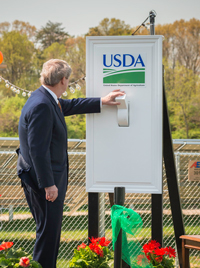 On Earth Day, Agriculture Secretary Tom Vilsack flipped the switch to symbolically activate USDA’s first solar array project in the National Capital Region.
On Earth Day, Agriculture Secretary Tom Vilsack flipped the switch to symbolically activate USDA’s first solar array project in the National Capital Region.
The 1.6 Megawatt (MW) solar farm, located at the George Washington Carver Center (Carver Center) in Beltsville, Maryland, is the largest solar array on federal property in this region. This project, which is part of a larger commitment to transform the facility into a model for sustainability, will help meet the President’s Capital Solar Challenge. The new solar farm is expected to provide about 2,000 megawatt hours (MWh), or 20% of the Carver Center facility annual electrical power requirements, and handle most of GWCC’s electrical needs during the day.
 “Today, USDA is another step closer to achieving its goal of energy independence. With this system, USDA is saving taxpayers over $300,000 annually in avoided energy costs,” said Vilsack. “As a Federal agency, USDA is leading the way in renewable energy in the National Capital Region. And we are proud to say that this 6.2 acre solar farm is the largest solar array on Federal property in this area.”
“Today, USDA is another step closer to achieving its goal of energy independence. With this system, USDA is saving taxpayers over $300,000 annually in avoided energy costs,” said Vilsack. “As a Federal agency, USDA is leading the way in renewable energy in the National Capital Region. And we are proud to say that this 6.2 acre solar farm is the largest solar array on Federal property in this area.”
There are over 5,000 state-of-the-art, industry-leading American made panels in this farm and it was built on what used to be Agriculture Research Service farmland, land that is now farming energy. The Carver Center consists of four interconnected buildings and grounds, which occupy about 45 acres of Federal land. The farm helps position USDA to meet President Obama’s new Executive Order goal to increase the share of electricity the Federal Government consumes from renewable sources to 30 percent.










